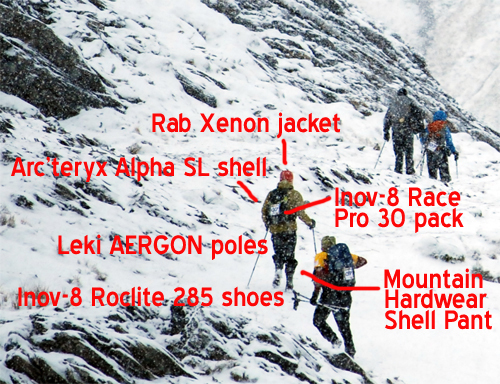We woke up in a blizzard. My feet were still wet and frozen from the night before. But Jason, a teammate in the 2010 Wenger Patagonian Expedition Race, was standing outside of the tent and yelling: “This shit is serious now!” Indeed, it was. My team was five days into an event through Patagonia’s Tierra del Fuego. We’d trekked for two days in utter wilderness, no trails in sight, and we still had almost 50 long kilometers to go until we’d switch disciplines and get in a kayak. It was an epic time. It was an ultimate proving ground for gear.

Earlier this year, I wrote extensively about the gear used on the Wenger Patagonian race. But this image above — taken at about 7 in the morning as the storm picked up — succinctly tells much more than any amount of words can say. I am the third person back in the line, a spec under towering mountains and whipping clouds.
Bar none, Patagonia was the biggest and most real gear test I have ever seen. We were surviving because of our equipment. A few wraps of fabric — merino-wool base layers, the Rab Xenon mid-layer jacket, and an Arc’teryx shell on top — were all that separated me from Patagonia’s inhospitable, howling void.

On a pass in the Darwin Mountains, somewhere near the end of the Earth at the tip of South America, this equipment did not fail me. We trekked fast through the snowstorm and then we ran. My pack bounced slightly as we went downhill, through valleys and thick woods, across a river, and onto a trail that led to sea level at the Beagle Channel. More than 12 hours later, we were in another tent. A final rest before the race’s end. The next morning I would pull my shell jacket back on. Then a kayak leg, 30 miles in deep water. Then another long trek. The same gear on my back, same shoes on my feet, moving me forward, keeping me warm, until, finally, the end came into sight.
—Stephen Regenold was captain of Team GearJunkie.com, a four-person squad that finished fifth in the 2010 Wenger Patagonian Expedition Race. It took the team six days, three hours, and 31 minutes to complete the course. A portion of this post appeared originally on VentureThere.com. Photos © Walter Alvial.







